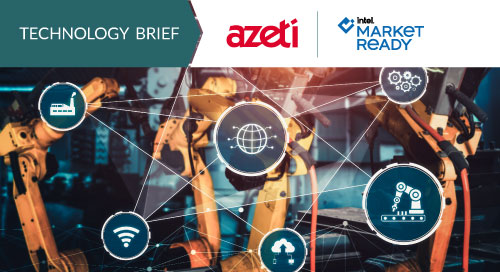Smart Factories Close Data Gaps Between OT and IT

Industry 4.0 has the potential to be a real game-changer. As manufacturers overcome data-related challenges, they become more agile and achieve considerable operational improvements. The promise of digital transformation in manufacturing lies in its ability to make data “talk” and deliver insights to act on. But challenges persist.
While data-driven manufacturing is not a particularly new idea, what is new is using data in context and applying learned lessons at scale. With industry 4.0, data from new sources such as machines outfitted with IoT sensors adds to the holistic picture and delivers context.
Manufacturers can see the forest and the trees—and plan accordingly. They can relieve some of the many pressures they face, including meeting sustainability goals, working with a talent shortage, and a growing need for remote monitoring of production processes.
Closing the Gaps Across OT and IT
“Unfortunately, the lofty ambitions of digital transformation frequently come to a grinding halt when the rubber meets the road,” says Florian Hoenigschmid, Vice President of Strategy and Sales at azeti, an IoT platform provider.
For one thing, because machines have been phased in over decades, the data they generate is not always uniform. “You can’t apply a one-size-fits-all solution when shop floors have to work with a lot of different machine interfaces, different protocols, and different standards,” Hoenigschmid says. Heterogeneous data is a challenge because it is not easy to process.
Patchwork solutions proliferate. Soon, you start missing the trees in the forest.
Second, even if you wrangle all the data in one format, granularity is a problem. “Getting data at a certain quality and scale that is useful for applications like machine learning is another challenge,” Hoenigschmid says. Low-resolution fuzzy data paints an inaccurate picture.
Gaps between operation technology (OT) and information technology (IT) integration further complicate the process of deriving insights. “There’s the software piece, the network piece, how to get data while still following corporate security policies—plus the OT piece of working with controllers and machines on the shop floor,” Hoenigschmid says. Getting data from these silos to talk to one another and in one language is no easy feat.
The azeti #IoT platform connects heterogeneous protocols and #machines on the shop floor to a central #software platform—solving many headaches in one fell swoop. @azeti_gmbh via @insightdottech
Digital Transformation in Manufacturing
The data challenges might be frustrating but are not insurmountable.
Case in point: The azeti IoT platform connects heterogeneous protocols and machines on the shop floor to a central IoT software platform, solving many headaches in one fell swoop. “We are able to connect most of the machines which are already on the production line into our software stack. On the software side, we convert raw data in an understandable way and make that available to our customers,” Hoenigschmid says.
The industrial rugged computers that azeti uses to bridge data gaps all run on Intel® processor-based hardware. “Intel technology helps us actually do the job of connecting and talking to machines, understanding the different protocols, and converting them to something that makes sense for our platform,” Hoenigschmid says.
Real-World Industry 4.0 Examples
Beyond building a robust data foundation, azeti also helps clients with the insights part of the equation.
For example, a large metal producer faced the following challenge: how to best operate the ventilation systems depending on the varying conditions of the smelting process. Conventional SCADA and PLC systems are used to control the operational conditions of the industrial ventilators, but they fall short for maintenance planning. Progressive deteriorations are difficult to recognize, SCADA data must be manually evaluated by the personnel, and temporary anomalies are recognized with delay.
The azeti solution supported the manufacturer by the means of a flexible platform for data collection, analysis, and visualization. After data acquisition, the relevant measurements are clustered over longer periods, while charts and a derived indicator are created on a dashboard. This provides the maintenance personnel with a tool to quantitively compare deterioration effects, detect anomalies in real time, and easily identify persistent patterns for reliable maintenance planning.
“The client now has a holistic and unified view of production-critical assets, which help them plan resources more efficiently,” Hoenigschmid says. “This provides the foundation to transition from preventive to predictive maintenance at some point. The process has been kicked off but is not yet concluded. Improved productivity and maximizing asset use are the welcome outcomes of the solution.
The IoT platform also helps metal companies use resources more efficiently. When workers fill dosing furnaces with metal to start production, many eyeball the amount of material to the fill line but miss the mark. Furnaces end up using wasted energy.
The platform connects to sensors and controllers that are part of the furnace so workers can see fill volume, and when to kick-start the melting process. “Maximizing utilization of these furnaces and using resources like gas efficiently can drive up efficiency,” Hoenigschmid says. “And that can add millions of dollars to the bottom line.”
Ushering in a Data Revolution
Digital transformation in manufacturing can unlock a range of additional possibilities. It can drive digital twins that simulate production processes so manufacturers can use resource-efficient methods and meet sustainability goals.
Product quality assessments can be fine-tuned. Data itself becomes valuable currency that can be traded as a service, enabling companies to rent their facilities to specialty manufacturers.
The digitalization of the shop floor may enable manufacturers to also negotiate lower insurance rates. Hoenigschmid foresees. He is excited about the future of smart manufacturing: “We can forecast the future in a very precise way and that is possible with very good and lots of granular data.”
In turn, manufacturers will finally work with the right toolkits in their digital transformation arsenal.
This article was edited by Georganne Benesch, Associate Content Director for insight.tech.